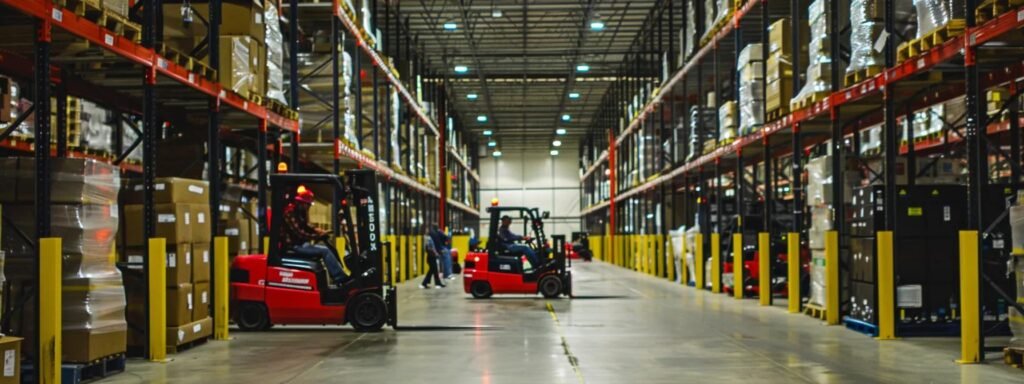
Table Of Contents:
- Forklift Equipment Service: How Expert Repair and Maintenance Reduce Downtime
- Why Is Forklift Equipment Service Essential for Minimizing Downtime?
- What Types of Forklift Repair Services Are Available to Reduce Downtime?
- How Do Preventative Maintenance Programs Extend Forklift Lifespan and Cut Downtime?
- Which Forklift Parts and Components Are Critical for Reliable Equipment Service?
- How Can Businesses Choose the Right Forklift Equipment Service Provider?
- What Are Proven Strategies to Minimize Forklift Downtime Through Equipment Service?
- What Are Frequently Asked Questions About Forklift Equipment Service and Downtime?
- Frequently Asked Questions
- Final Thoughts
Optimize Forklift Operations with Expert Repair and Maintenance
The smooth operation of industrial equipment is critical to ensuring productivity and profitability in today’s fast-paced business environment. Forklifts, the workhorses of warehouses and factories, are essential for material handling and inventorymanagement. When these machines experience breakdowns or underperformance, downtime can severely disrupt operations, affecting the supply chain and profitability. Expertforkliftequipmentservice—including repair and preventative maintenance—is key to minimizing interruptions, extending equipment lifespan, and reducing total cost of ownership. This article explores the benefits of regular forkliftservice and provides guidance on selecting appropriate repair services.
Transitioning from overarching concerns to specifics, the following sections address key questions regarding forkliftequipmentservice with actionable, evidence-based strategies that support operational efficiency and enhanced equipment performance.
Why Is Forklift Equipment Service Essential for Minimizing Downtime?
Regular forkliftservice is vital to ensuring continual uptime. Proactive maintenance minimizes catastrophic failures that lead to downtime, which can disrupt operations, reduce output, and negatively affect productivity, customer satisfaction, and the supply chain. Without proper maintenance, forklifts are more likely to suffer unexpected breakdowns that delay shipments, compromise worker safety, and increase emergency repair expenses.
What Are the Costs and Consequences of Forklift Downtime?
Downtime directly reduces production output and revenue. Beyond lost production time, it results in higher labor costs due to idle workers and overtime needed to catch up. Even brief periods of inoperability can result in significant financial losses and damage company reputation through recurrent breakdowns. Consistent, scheduled service is therefore a wise investment to avoid these costly disruptions.
How Does Regular Forklift Service Prevent Unexpected Failures?
Routine service detects early signs of battery degradation, hydraulic leaks, and tire wear before they become critical issues. Scheduled checks and maintenance allow for repairs during non-peak hours, thus avoiding unplanned stoppages. Regular updates to components and proper lubrication also reduce friction and overheating, which in turn extends the life of essential parts and lessens emergency repair costs.
Which Forklift Brands Require Specialized Service?
Different forklift brands possess distinct engineering characteristics that require specialized service protocols. For example, Toyota forklifts have advanced proprietary systems demanding specific diagnostic tools and training. Similarly, Crown, Hyster, and Yale forklifts have unique hydraulic and transmission designs. Employing technicians who are specifically trained for these brands ensures precise, high-quality service that minimizes downtime and maintains peak performance.
Optimizing Your Forklift Operations with Expert Repair and Maintenance

A range of repair services is available to address various forklift issues. Options include emergencyrepairs and scheduled maintenance interventions. Services cover troubleshooting electrical issues, diagnosing engine or transmission problems, and replacing worn parts. Many providers also offer on-site emergencyrepairs, which quickly restore functionality and help reduce production losses due to downtime.
How Does Emergency Forklift Repair Work to Restore Operations Quickly?
Emergencyrepair services focus on rapid restoration of forklift operations. When a breakdown occurs, certified technicians quickly diagnose the issue—whether it’s a battery failure, hydraulic leak, or electrical fault—and perform immediate remedial actions. Temporary fixes may be applied until a permanent solution is implemented. The availability of pre-stocked critical parts is crucial for reducing repair waiting times and minimizing operational disruption.
What Are Common Forklift Problems and How Are They Fixed?
Common issues include battery degradation, tire wear, hydraulic malfunctions, transmission problems, and brake failures. For battery issues, technicians may recondition or fully replace the battery. Worn tires are replaced with appropriate pneumatic or cushion options depending on the environment. Hydraulic leaks are fixed by repairing seals or replacing faulty lines, while transmission and brake problems are addressed by overhauling gear systems or replacing brake pads. In all cases, expert and prompt intervention is necessary to limit equipmentdowntime.
How Much Does Forklift Repair Typically Cost?
Repair costs vary depending on the issue, parts required, and expertise needed. Routine repairs generally incur modest costs while emergencyrepairs may involve premium charges due to the rapid response time. Comprehensive repairs can range from a few hundred to several thousand dollars. When services are covered under warranty or a maintenance contract, costs can be significantly reduced. Evaluating the total cost of ownership versus savings from minimized downtime is essential for budgeting.
How Do Brand-Specific Repairs Differ for Toyota, Crown, Hyster, and Yale Forklifts?
Repairs for different brands can vary notably. Toyota forklifts often use proprietary diagnostic systems that require specialized tools for effective troubleshooting. Crown forklifts depend on robust hydraulic systems that require specific replacement parts; Hyster models have distinct frame and powertrain designs that need targeted repairs; while Yale forklifts may require precise electrical adjustments. Specialized training for these brands ensures that repairs are accurately and efficiently executed, preserving the equipment’s long-term reliability.
How Do Preventative Maintenance Programs Extend Forklift Lifespan and Cut Downtime?
Preventative maintenance programs proactively address issues before they evolve into major failures. By scheduling routine inspections, servicing, and systematic replacement of worn parts, these programs keep forklifts operating at peak efficiency. A structured maintenance schedule significantly reduces the risk of unexpected breakdowns and optimizes fleet performance. Furthermore, regular maintenance lowers overall repair costs by addressing minor issues early, thereby delivering a high return on investment (ROI) and boosting productivity.
What Is Included in a Comprehensive Forklift Maintenance Schedule?
A robust maintenance schedule involves routine inspections of critical components such as batteries, tires, hydraulic systems, and brakes. It also includes regular oil and filter changes, lubrication of moving parts, and recalibration of control systems. Such schedules typically encompass daily, weekly, and monthly checks as well as thorough quarterly or annual inspections. Detailed documentation of all maintenance activities facilitates predictive analysis and timely interventions to prevent catastrophic failures.
How Often Should Forklifts Be Serviced to Avoid Breakdowns?
The service frequency depends on usage intensity, operating conditions, and manufacturer guidelines. In busy industrial environments, daily or weekly inspections with monthly servicing may be necessary. In less demanding settings, quarterly maintenance might suffice. Manufacturers often recommend preventive checks every few hundred operating hours to allow technicians to adjust and recalibrate systems, ensuring safety and reducing the chance of unexpected breakdowns.
What Are the Benefits of Using Certified Technicians for Maintenance?
Certified technicians offer the assurance that repairs and maintenance meet stringent industry standards. Trained to use specialized diagnostic tools, they are adept at identifying potential issues in various forklift brands. Their expertise not only extends the service life of forklift components but also ensures adherence to safety regulations such as those from the Occupational Safety and Health Administration (OSHA). This professional approach reduces repeat problems and maximizes overall equipment reliability while ensuring consistent operational performance.
How Does Preventative Maintenance Provide ROI for Businesses?
Preventative maintenance delivers measurable ROI by reducing downtime, cutting repair costs, and extending equipment life. Regular servicing prevents minor issues from escalating into expensive emergencies, allowing businesses to budget predictable maintenance expenses. Stable equipment performance enhances workforce safety and efficiency, which translates directly into improved productivity and operational output. Data-driven maintenance strategies further help in optimizing service frequencies and reducing overall costs.
Which Forklift Parts and Components Are Critical for Reliable Equipment Service?

Key forklift components such as batteries, tires, hydraulic systems, brakes, and transmission parts are critical for ensuring operational reliability and safety. Routine maintenance or timely replacement of these parts is essential to prevent unexpected failures. The speed and quality of repairs depend on the availability of these parts—whether genuine OEM or high-quality aftermarket options. Choosing the right parts can impact not only the immediate repair outcome but also the long-term durability and efficiency of the equipment.
When Should Forklift Batteries and Tires Be Replaced?
Batteries typically require replacement every three to five years, depending on use and charging infrastructure, while performance tests help determine the need for replacement. Tires must be regularly inspected for signs of wear such as cracks or tread loss; pneumatic tires used on rough surfaces may wear out faster than cushion tires used indoors. Replacing components when deterioration is detected is crucial for maintaining safety and ensuring consistent performance.
What Are the Differences Between Genuine and Aftermarket Forklift Parts?
Genuine forklift parts are manufactured by the original equipment manufacturer (OEM) and are specifically designed for compatibility and longevity with the equipment. They usually carry a warranty and are rigorously tested to adhere to safety standards. In contrast, aftermarket parts are typically less expensive and may vary in quality and fitness. While some in the aftermarket perform on par with OEM parts, others may not, making it important to balance cost considerations with the need for long-term reliability.
How Does Parts Availability Affect Repair Speed and Downtime?
Quick access to forklift parts is a critical factor in reducing repair times and downtime. When parts are readily available—either in stock or quickly delivered—service providers can complete repairs more promptly, minimizing operational disruption. Conversely, delays in parts procurement can extend downtime significantly, reducing productivity and increasing overall repair costs. Efficient supply chains and reliable inventorymanagement by service providers are therefore vital to maintaining equipmentuptime.
How Can Businesses Choose the Right Forklift Equipment Service Provider?
Choosing the right forkliftservice provider is essential for maintaining continuous operations. A reliable provider not only possesses strong expertise in repair and maintenance but also offers flexible solutions tailored to diverse equipment needs. Key considerations include a proven track record, rapid response times, certified and well-trained technicians, and the capability to perform brand-specific repairs. Additionally, transparent pricing, customized service plans, and excellent customerservice are important factors that enhance long-term asset management and operational productivity.
What Factors Should Be Considered When Selecting a Forklift Repair Service?
Businesses should evaluate a service provider’s experience, reputation, and technician certifications. Quick response times and 24/7 support are critical, especially during emergencyrepairs. Transparency in pricing and the availability of genuine parts are also significant, as is a robust service plan backed by positive customer testimonials and case studies. A provider that effectively combines technical expertise with strong customer support will streamline the repair process and reduce downtime.
Why Is Rapid Response Time Crucial for Reducing Downtime?
Every minute of forkliftdowntime can lead to lost production and increased labor costs. Rapid response is essential during peak times to prevent cascading delays in the supply chain. Providers who emphasize swift diagnostics and on-site repairs help restore operations quickly, which in turn improves overall customer satisfaction. Service-level agreements (SLAs) and emergency protocols are useful indicators of a provider’s commitment to minimizing downtime.
How Do Customized Service Plans Meet Specific Business Needs?
Customized service plans are tailored to match the unique operational requirements, usage patterns, and financial goals of each business. These plans typically combine scheduled maintenance visits, priority emergencyrepairs, and access to dedicated on-call technicians. By aligning maintenance strategies with production schedules, businesses can avoid unexpected repair costs and prolong equipment lifespan. Regular performance reviews and detailed reporting in these plans further ensure that the service adapts to changing business needs and maximizes return on investment.
What Are Proven Strategies to Minimize Forklift Downtime Through Equipment Service?

Implementing proactive maintenance strategies is essential for minimizing downtime. Effective techniques include regular equipment inspections, continuous monitoring through telematics, and structured maintenance schedules. Advanced diagnostics help predict when repairs are needed, while on-site training for operators and technicians fosters early identification of potential issues. Together, these practices help maintain operational productivity while decreasing the likelihood of unexpected setbacks.
How Do Forklift Telematics and Remote Diagnostics Improve Maintenance?
Telematics and remote diagnostics provide real-time data on forklift performance—tracking parameters such as engineefficiency, battery status, and usage hours. This information enables service providers to anticipate maintenance needs before minor issues become major problems. By facilitating targeted interventions, these technologies reduce response times and support strategic planning that keeps equipment running smoothly.
What Case Studies Demonstrate Successful Downtime Reduction?
Several case studies illustrate the benefits of structured maintenance programs. For example, one manufacturing company saw a significant reduction in unplanned downtime after implementing a preventive maintenance plan with a certified service provider. In another instance, a distribution center that adopted telematics-based monitoring reduced emergency repair calls considerably. Such examples underscore how proactive maintenance and advanced diagnostics translate into measurable improvements in efficiency and reduced downtime.
How Does Regular Equipment Inspection Prevent Costly Failures?
Scheduled inspections allow technicians to identify early signs of wear or damage—such as abnormal engine noise, inefficient hydraulics, or electrical irregularities—before they lead to severe failures. By addressing these issues promptly, companies can avoid costly emergencyrepairs and maintain overall safety. Regular inspections not only guard against sudden breakdowns but also extend the overall lifespan of the equipment.
What Are Frequently Asked Questions About Forklift Equipment Service and Downtime?
Managers and maintenance supervisors often have questions about service intervals, diagnostic methods, and emergency repair timelines. Clear guidelines and effective maintenance protocols can greatly reduce costs while boosting equipmentefficiency.
How Often Should I Service My Forklift to Avoid Downtime?
It is generally recommended to serviceforklifts monthly with more intensive reviews scheduled quarterly or annually. Daily or weekly inspections should focus on critical components like battery condition, tire integrity, and hydraulic fluid levels. Adhering to manufacturer recommendations and using telematics data further refines the service schedule.
What Are the Signs of a Failing Forklift Battery or Component?
Common signs include sluggish starts, reduced power, prolonged charging times, unusual noises, fluid leaks, and visible wear on tires. Early detection through regular inspections helps prevent further damage and minimizes unplanned downtime.
How Quickly Can Emergency Repairs Be Completed?
Emergencyrepairs typically begin within one to two hours after reporting an issue and are often completed within the same business day. Rapid on-site diagnostics and the availability of replacement parts are key to restoring operations swiftly.
How Do Certified Technicians Impact Repair Quality?
Certified technicians use proprietary tools and follow manufacturer standards, which minimizes the likelihood of recurring issues. Their expertise not only improves repair quality but also enhances overall equipment reliability and performance.
What Role Does Preventative Maintenance Play in Long-Term Cost Savings?
Preventative maintenance helps identify issues before they escalate into costly emergencies. This proactive approach reduces repair costs, extends equipment life, and stabilizes operational performance, ultimately lowering the total cost of ownership.
Frequently Asked Questions
Q: How frequently should a forkliftbe serviced to minimize downtime? A: Forklifts should typically be serviced monthly with more thorough inspections quarterly or annually. Daily checks on critical components such as batteries, tires, and hydraulic systems help catch issues early and ensure continuous operation.
Q: What are the primary signs that indicate a forkliftcomponent is failing? A: Indicators include reduced power output, longer battery charging times, unusual noises, visible leaks, and tire wear. Regular inspections can detect these signs early to mitigate the risk of breakdowns.
Q: How does emergencyforkliftrepair work, and how fast can repairsusually be completed? A: Emergency repairs involve immediate on-site diagnostics and swift intervention. Typically, repairs can begin within one to two hours and are often completed within the same business day.
Q: Why is it important to use certified techniciansfor forkliftrepairsand maintenance? A: Certified technicians ensure that repairs adhere to manufacturer standards using specialized tools. Their expertise reduces the risk of repeat issues and enhances long-term equipment reliability.
Q: How does preventative maintenance contribute to costsavings in forkliftoperations? A: By identifying problems early and preventing escalation, preventative maintenance minimizes emergency repair costs and extends equipment lifespan, resulting in lower overall ownership costs.
Final Thoughts
This comprehensive overview demonstrates that expertforkliftrepair and maintenance are critical to minimizing downtime and ensuring operational efficiency. Regular servicing, customized maintenance schedules, and rapid-response repairs help safeguard productivity and reduce unexpected expenses. Investing in certified technicians and advanced diagnostic technologies further enhances equipment reliability and cutting maintenance costs. In summary, prioritizing preventative maintenance and partnering with qualified service providers ensures that forklifts operate at peak efficiency, leading to sustained business success and improved profitability.
